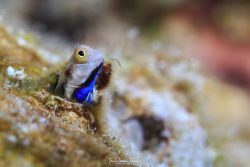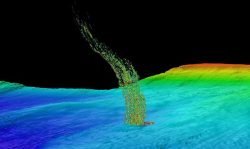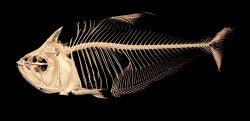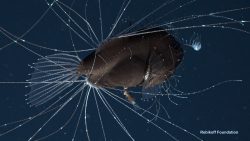We swim in it, the sun sets over it, love songs are written about it and it covers 70% of the earth’s surface, yet we know so little about our deep blue sea. Oceans inspire some of the most puzzling questions and greatest discoveries on earth, and here at UW, researchers from across the sciences are dedicated to better understanding what’s in them, what’s changing about them, and how we can preserve these essential parts of our habitat.
To commemorate World Oceans Day on June 8, we’ve compiled a short list of some of the most curious things discovered in the ocean, thanks to research here at the College of the Environment.

1. There are microbes in the ocean that can breathe arsenic and love it
It’s been known for some time that some micro-organisms on land can sustain themselves using elements apart from oxygen (think the microbes that gather in hot springs or contaminated freshwater). Now, thanks to UW oceanographer Gabrielle Rocap, we know that microbes in the tropical Pacific ocean can do the same. “The idea that organisms could be using arsenic to make a living — it’s a whole new metabolism for the open ocean,” she says. This discovery means that some organisms in the ocean may survive or even thrive in ocean water with higher levels of arsenic — a future scenario worth pondering as we consider the effects of climate change. Read more about arsenic breathing microbes.

2. Tiny bottom-dwelling fishes are like kettle corn to hungry creatures in coral reefs
Small fish perform a critical function on coral reefs — they are snack food. The vast majority of tiny fishes that are less than half an inch long on reefs will be eaten within the first few weeks of their existence, which allows for larger reef fishes to flourish. “Entire reef communities are being fueled by some of the smallest vertebrates on earth — including some species that live for an average of just 65 days,” said co-author Luke Tornabene at the UW School of Aquatic and Fishery Sciences. In total, these fish represent almost 60 percent of all fish tissue consumed on reefs. “These fish are like candy,” said Simon Brandl, a Banting postdoctoral research fellow at Simon Fraser University in British Columbia. By studying changes in the populations of these tiny snack fish, scientists can find clues about the health and status of a reef in general. Read more about snack food fishes on coral reefs.

3. The Juan de Fuca Plate has gas
Faults and cracks at the bottom of the North Pacific Ocean are squeezing out bubbles of methane (stop laughing, this is serious science). More than 1,700 bubble plumes have been found 30 miles off the Washington coast, indicating pressure points along the Juan de Fuca tectonic plate. “If you were able to walk on the seafloor from Vancouver Island to the Columbia River, you would never be out of sight of a bubble plume,” said lead author Paul Johnson, a UW professor of oceanography. The geology of these plumes suggests that the gas and fluid rises through the faults, generated by the motion of the same geologic plates that produce major offshore earthquakes in the Pacific Northwest. The locations where these bubbles emerge provide important clues to what might happen during a major offshore earthquake. Read more about the methane bubble plumes along the Juan de Fuca Plate.

4. Some fish employ demolition derby tactics to catch their dinner
Not just a pretty face, the blunt-faced fish (aka Roeboides affinis) uses teeth on its nose to ram into other fish, devouring scales as they fly off from the force of impact. Adam Summers, professor of aquatic and fishery sciences and biology at UW Friday Harbor Laboratories has conducted CT scans on these fish and confirmed that they are able to digest entire scales. “Roeboides is like a car that intentionally runs a stop sign and t-bones another car — then picks up the tail lights and window trim knocked off in the crash. It is a crazy strategy,” says Summers. About 50 fish species are classified as scale-eaters, and all of them live in the tropics. Read more about the clever scale-eating fishes of the tropics.

5. A female anglerfish is about 60 times larger than her mate, and they remain attached for life (literally)
A species of deep-sea anglerfish never before seen alive by humans has been recorded while mating —and it makes for some jaw-dropping viewing. This video was recorded at a depth of 2,660 feet and shows the female moving through the water with a tiny male attached to her body, the tissues and circulatory systems of the two fused, while he is fed by nutrients received through her blood. The male becomes a “sexual parasite,” hanging on for the rest of his life and unable to free himself, fertilizing the eggs produced by the female. The male completely loses his individuality and the couple becomes a single functioning organism (relationships, amirite?) Deep sea anglerfishes are found in all oceans around the world, yet the roughly 160 known species are extremely rare. Just ask Ted Pietsch, University of Washington professor emeritus of aquatic and fishery sciences, who is the world’s expert on anglerfishes and has described and named more than 70 new species. “This is a unique and never-before-seen thing,” said Pietsch. “It’s so wonderful to have a clear window on something only imagined before this.” Read more about the jaw-dropping mating habits of the Anglerfish.
While this research didn’t strictly come from the UW, its sheer peculiarity earns it a spot on this list.
Want to learn more about our research? Subscribe to the College of the Environment newsletter and follow us on Twitter, Facebook and Instagram.

